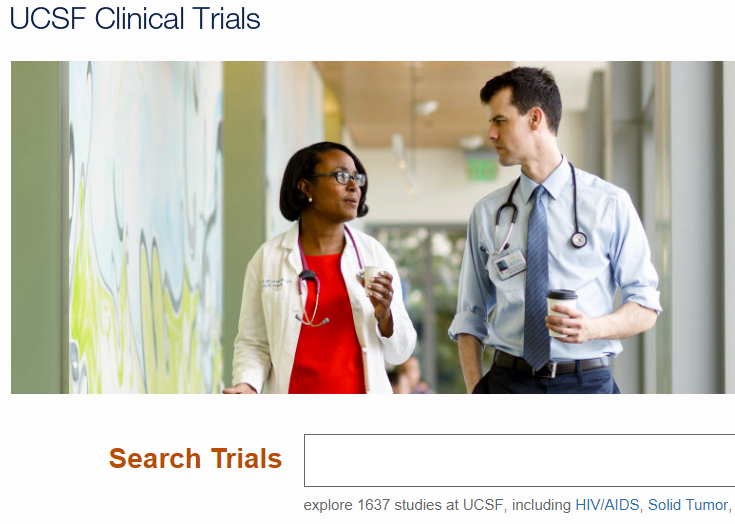by Leslie Yuan and Anirvan Chatterjee
UCSF launched its new Clinical Trials website in late 2016 (see blog article). Developed by the Research Technology team in the Clinical & Translational Science Institute (CTSI), the site makes it easy for UCSF patients, doctors, and researchers to find, learn about, and engage with UCSF’s clinical trials across hundreds of different health conditions.
The system features:
- A user-friendly search engine supporting incremental search and spell correction
- Dedicated landing pages for each health condition (e.g., epilepsy, liver cancer)
- An easy-to-digest web page for every trial, including its recruiting status, eligibility criteria, study description, and a way to learn more (e.g., WISDOM Study, PairedPLIE)
- Pages carefully hand-optimized for search engines – including URLs, page titles, description tags, semantic HTML, and rich machine-readable metadata
- A pragmatic data ingest process that sources current trial data from public and internal sources, and that handles dirty and incomplete data
- Informational pages in English and three additional languages
The approach worked! Just six months after launch, the website was getting twice as much traffic as the system it replaced. Within 21 months, the traffic was three times that of the original system.
Scaling up across UC
Based on this initial success, CTSI’s Research Technology team competed for and won a two-year NIH supplement grant to work with four other UC Health campuses (UCLA, UCSD, UCD, and UCI) to create a UC wide clinical trial finder, as well as to spin up campus-specific sites. The team subsequently worked with the UC Cancer Consortium to create a UC wide clinical trials site specifically for the cancer research community.
UC Health now has six public clinical trial finder websites, each one benefiting from the design and research that went into the original UCSF site:
- UCSF Clinical Trials — featuring 1600 studies
- UCSD Clinical Trials — featuring 900 studies
- UC Irvine Clinical Trials — featuring 400 studies
- UC Davis Clinical Trials — featuring 300 studies
- University of California Clinical Trials — featuring 4000 studies from across all 5 UC Health campuses
- UC Cancer Consortium Clinical Trials — featuring 700 cancer studies from 5 UC Health campuses
A seventh site for UCLA Clinical Trials is under discussion.
Our scaling strategy
- Build partnerships.
Taking a UCSF developed system and scaling it up across the University of California was possible only because of some critical partners.
- The NIH funded and supported much of this work.
- UC BRAID enabled collaboration across campuses, helping us make connections between stakeholders, and offering valuable suggestions throughout the process.
- The UC Cancer Consortium made connections across the UC Health enterprise to provide input for its site.
- And the UCCSC 2018 conference provided a space to connect in person with partners from across the state.
In the end, each campus is a bit different, and for an “enterprise trial finder site” there were steps to “get all the political ducks in a row.” We shared our tactics with the other institutions, such as proactive outreach to our own departments, groups and owners that maintain their own robust disease/condition-specific trial finders (e.g., Cancer Center, UCSF Health, UCSF Memory and Aging Center). The message was two-fold:
- Our goal with the UCSF Trial Finder was not to cannibalize their traffic, but to send more traffic to their sites.
- We hoped to help groups who have active studies but do not have the resources to promote their studies as actively as bigger organizations.
Focus on product management.
The UCSF team embarked on a mission of “eating the elephant, one bite at a time:”
Tracking the progress, contact information, and status of each campus partner using Google Sheets
- Setting weekly meetings and scheduling partner calls and demos as needed
- Demonstrating each partner’s small wins to all the partners as mini-milestones were reached, thus encouraging other partners to engage and sparking some friendly UC competitive spirit
- Presenting the “finished” system at the 2018 UC BRAID retreat to show off the shared work among all the teams
Make pragmatic tech choices.
We used templating and pluggable stylesheets to allow every campus to customize its site look and feel. But before we started, we made sure to look at the branding guidelines for every UC, to make sure that we were making the right parts of the design sufficiently tweakable.
- Every site is centrally hosted, and this might ordinarily require every partner to change DNS settings whenever we change servers. Instead, we asked partners to set a CNAME DNS entry pointing to a system we controlled. This allows us to switch servers easily, without needing to ask partners to keep changing DNS settings.
- Every website is built using a series of simple configuration options to reduce manual maintenance work. For example, given a campus-specific geographic location string (e.g., for UCSF, “San Francisco Bay Area”), we can use that string across the website for optimized geographic SEO. Or given an institution’s main website (e.g., for UCSD, https://www.ucsd.edu/), we can automatically point to the favicon on that main site, and not have to manually configure it.
 Leslie Yuan is CIO & director, Virtual Home, Clinical & Translational Science Institute, UC San Francisco.
Leslie Yuan is CIO & director, Virtual Home, Clinical & Translational Science Institute, UC San Francisco.
 Anirvan Chatterjee is director of data strategy, Clinical & Translational Science Institute, UC San Francisco
Anirvan Chatterjee is director of data strategy, Clinical & Translational Science Institute, UC San Francisco







